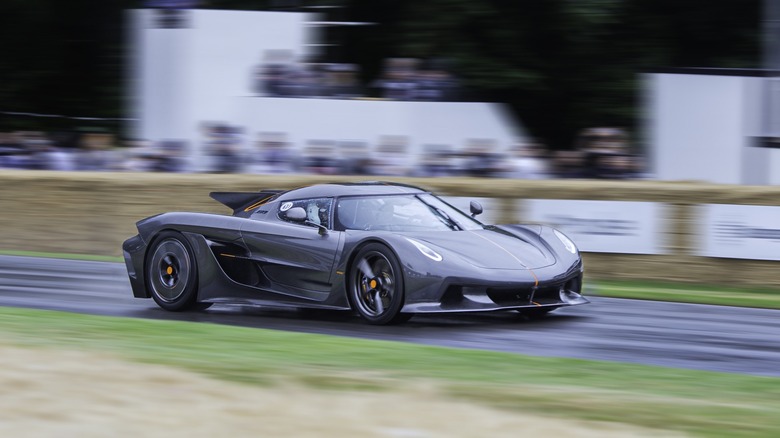All About The 5.0L Twin-Turbo V8 Powering The Koenigsegg Jesko Absolut
When it comes to hypercars, there are few companies pushing the limits of performance and engineering more than the iconic Swedish manufacturer Koenigsegg. Since the early 2000s, Koenigsegg has set its sights on producing the fastest and highest-performance cars on the planet. A quick run through the history of its lineup shows that the company has achieved that goal many times over. However, the end-all, be-all of modern Koenigsegg is the Jesko Absolut. It's the most hardcore version of the already epic Koenigsegg Jesko, and it's truly a piece of automotive art.
With an incredibly low drag coefficient of only 0.278 Cd, the Jesko Absolut is one of the most aerodynamic road-going cars in history. Combining that remarkable aerodynamic efficiency with over 1,600 bhp makes for a devastatingly fast combination, but where does all that power come from? Let's take a look at the V8 engine that powers the Jesko Absolut.
Twin-turbo, lightweight, and high-revving
The Koenigsegg Jesko Absolut uses a twin-turbocharged 5.0-liter V8 engine like the majority of Koenigsegg's models. However, the focus of this engine was to keep things as light as possible in order to maximize efficiency.
The first and most prominent feature of the engine is its lightweight crankshaft. Weighing in at only 28 pounds, it's formed from a single piece of steel billet, making it not just light but extremely robust. The rest of the rotating assembly follows suit. Koenigsegg developed model-specific super-light connecting rods and pistons. As a result, the lightweight rotating assembly minimizes the engine's tendency to vibrate and allows a smooth and high-revving engine. Moreover, a lightweight rotating assembly allows the engine to sprint through the rev range.
The engine has a pair of twin ceramic ball-bearing turbochargers for rapid response and minimal turbo lag. On standard pump gas, the Koenigsegg Jesko Absolut runs a remarkably 24.65 PSI peak boost level. On E85, that number goes up to nearly 32 PSI. The total power output from those fuels comes to an eye-watering 1,280 horsepower and 1,600 horsepower, respectively. In addition, it makes an unbelievable 1,106 pound-feet of torque. Let's take a deeper dive into the technical specs of the engine to gain a better understanding of how this car produces so much power.
Koenigsegg Jesko Absolut Engine Techinical Details
On the surface, the Jesko Absolut's engine is a pretty standard dual-overhead camshaft V8 assembly. It has four valves per cylinder and uses a flat-plane crankshaft layout. This design leads to even firing across the engine banks, creating a unique (and amazing) engine sound. Instead of a standard oil pan, though, the Jesko Absolut has a dry-sump oiling system.
With a compression ratio of 9.0 to 1, it's not remarkably high. It has a bore of 92mm and a stroke of 95.25mm. It also has a sequential fuel injection system that has cylinder pressure and back pressure sensors. While the sensors are a little out of the norm, reading the rest of these engine specs wouldn't lead you to think it's one of the most powerful production car engines ever built.
Where it does differ from most, though, is in its precise engineering with efficiency in mind. The engine block and cylinder heads are constructed entirely from aluminum, and the intake manifold, like the car's chassis, is made from carbon fiber and features highly optimized tracts for maximum induction airflow. Finally, the exhaust system is fully tig-welded and ceramic-coated. It's made from Inconel, an extremely lightweight superalloy, and has a wall thickness of only 1/32 of an inch. All said and done, the total engine assembly weight comes in at just over 400 pounds.


